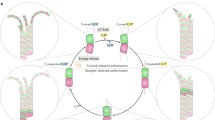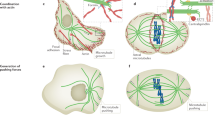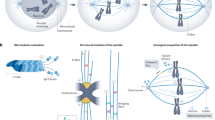Abstract
Microtubules are biopolymers that assemble from tubulin dimers into hollow tubes and play an important role in cellular organization. Their fascinating properties and variety of functions, like for example chromosome segregation, sperm propagation and polarity establishment, have made them a popular subject of study. In this perspective I focus on the contribution of minimal in vitro systems to our understanding of microtubule organization within the physical confinement of a cell.



Similar content being viewed by others
References
Bieling P, Laan L, Schek H, Munteanu EL, Sandblad L et al (2007) Reconstitution of a microtubule plus-end tracking system in vitro. Nature 450:1100–1105
Bieling P, Telley IA, Surrey T (2010) A minimal midzone protein module controls formation and length of antiparallel microtubule overlaps. Cell 142:420–432
Braun M, Lansky Z, Fink G, Ruhnow F, Diez S et al (2011) Adaptive braking by Ase1 prevents overlapping microtubules from sliding completely apart. Nat Cell Biol 13:1259–1264
Brouhard GJ, Stear JH, Noetzel TL, Al-Bassam J, Kinoshita K et al (2008) XMAP215 is a processive microtubule polymerase. Cell 132:79–88
Cosentino Lagomarsino M, Tanase C, Vos JW, Emons AM, Mulder BM et al (2007) Microtubule organization in three-dimensional confined geometries: evaluating the role of elasticity through a combined in vitro and modeling approach. Biophys J 92:1046–1057
Elbaum M, Kuchnir Fygenson D, Libchaber A (1996) Buckling microtubules in vesicles. Phys Rev Lett 76:4078–4081
Faivre-Moskalenko C, Dogterom M (2002) Dynamics of microtubule asters in microfabricated chambers: the role of catastrophes. Proc Natl Acad Sci USA 99:16788–16793
Gennerich A, Carter AP, Reck-Peterson SL, Vale RD (2007) Force-induced bidirectional stepping of cytoplasmic dynein. Cell 131:952–965
Good MC, Vahey MD, Skandarajah A, Fletcher DA, Heald R (2013) Cytoplasmic volume modulates spindle size during embryogenesis. Science 342:856–860
Grill SW, Gonczy P, Stelzer EHK, Hyman AA (2001) Polarity controls forces governing asymmetric spindle positioning in the Caenorhabditis elegans embryo. Nature 409:630–633
Hazel J, Krutkramelis K, Mooney P, Tomschik M, Gerow K et al (2013) Changes in cytoplasmic volume are sufficient to drive spindle scaling. Science 342:853–856
Holy TE, Dogterom M, Yurke B, Leibler S (1997) Assembly and positioning of microtubule asters in microfabricated chambers. Proc Natl Acad Sci USA 94:6228–6231
Horio T, Hotani H (1986) Visualization of the dynamic instability of individual microtubules by dark-field microscopy. Nature 321:605–607
Kerssemakers JWJ, Munteanu EL, Laan L, Noetzel TL, Janson ME et al (2006) Assembly dynamics of microtubules at molecular resolution. Nature 442:709–712
Kinoshita K, Arnal I, Desai A, Drechsel DN, Hyman AA (2001) Reconstitution of physiological microtubule dynamics using purified components. Science 294:1340–1343
Laan L, Pavin N, Husson J, Romet-Lemonne G, van Duijn M et al (2012a) Cortical dynein controls microtubule dynamics to generate pulling forces that position microtubule asters. Cell 148:502–514
Laan L, Roth S, Dogterom M (2012) End-on microtubule-dynein interactions and pulling-based positioning of microtubule organizing centers. Cell Cycle 11:3750–3757
Minc N, Burgess D, Chang F (2011) Influence of cell geometry on division-plane positioning. Cell 144:414–426
Mitchison T, Kirschner M (1984) Dynamic instability of microtubule growth. Nature 312:237–242
Mulder B, Janson M (2014) Microtubule networks for Plant Cell Division. Sys Synth Biol. doi:10.1007/s11693-014-9142-x
Nedelec FJ, Surrey T, Maggs AC, Leibler S (1997) Self-organization of microtubules and motors. Nature 389:305–308
Pavin N, Laan L, Ma R, Dogterom M, Julicher F (2012) Positioning of microtubule organizing centers by cortical pushing and pulling forces. New J Phys. doi:10.1088/1367-2630/14/10/105025
Picone R, Ren X, Ivanovitch KD, Clarke JD, McKendry RA et al (2010) A polarised population of dynamic microtubules mediates homeostatic length control in animal cells. PLoS Biol 8:e1000542
Pinot M, Chesnel F, Kubiak JZ, Arnal I, Nedelec FJ et al (2009) Effects of confinement on the self-organization of microtubules and motors. Curr Biol 19:954–960
Reck-Peterson SL, Yildiz A, Carter AP, Gennerich A, Zhang N et al (2006) Single-molecule analysis of dynein processivity and stepping behavior. Cell 126:335–348
Romet-Lemonne G, VanDuijn M, Dogterom M (2005) Three-dimensional control of protein patterning in microfabricated devices. Nano Lett 5:2350–2354
Terenna CR, Makushok T, Velve-Casquillas G, Baigl D, Chen Y et al (2008) Physical mechanisms redirecting cell polarity and cell shape in fission yeast. Curr Biol 18:1748–1753
Tran PT, Marsh L, Doye V, Inoue S, Chang F (2001) A mechanism for nuclear positioning in fission yeast based on microtubule pushing (vol 153, pg 397, 2001). J Cell Biol 153:891
Walker RA, O’Brien ET, Pryer NK, Soboeiro MF, Voter WA et al (1988) Dynamic instability of individual microtubules analyzed by video light microscopy: rate constants and transition frequencies. J Cell Biol 107:1437–1448
Weisenberg RC (1972) Microtubule formation in vitro in solutions containing low calcium concentrations. Science 177:1104–1105
Acknowledgments
I would like to thank M. Dogterom for constant support and insightful discussions during my research on microtubule organization in her group; B. Neugeboren and M. Costa Coehlo for critical reading of the manuscript; M. Mueller for insightful discussions. I gratefully acknowledge support from the Human Frontiers Science Program.
Author information
Authors and Affiliations
Corresponding author
Rights and permissions
About this article
Cite this article
Laan, L. Experiments inside a box lead to out-of-the-box ideas on cellular organization. Syst Synth Biol 8, 223–226 (2014). https://doi.org/10.1007/s11693-014-9139-5
Received:
Revised:
Accepted:
Published:
Issue Date:
DOI: https://doi.org/10.1007/s11693-014-9139-5




